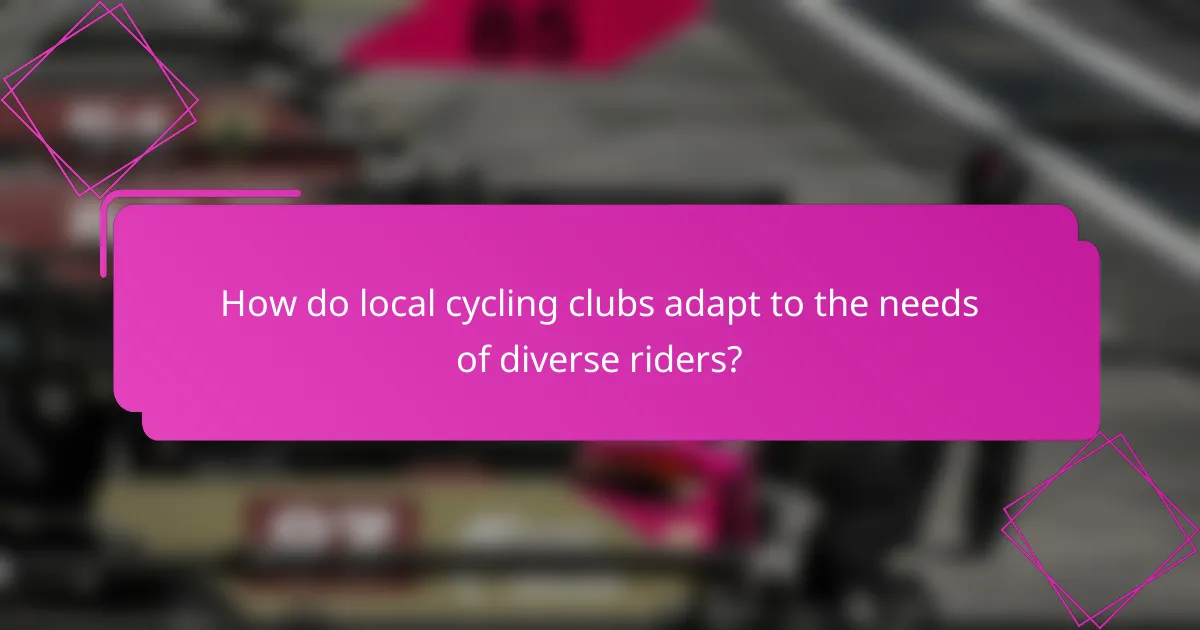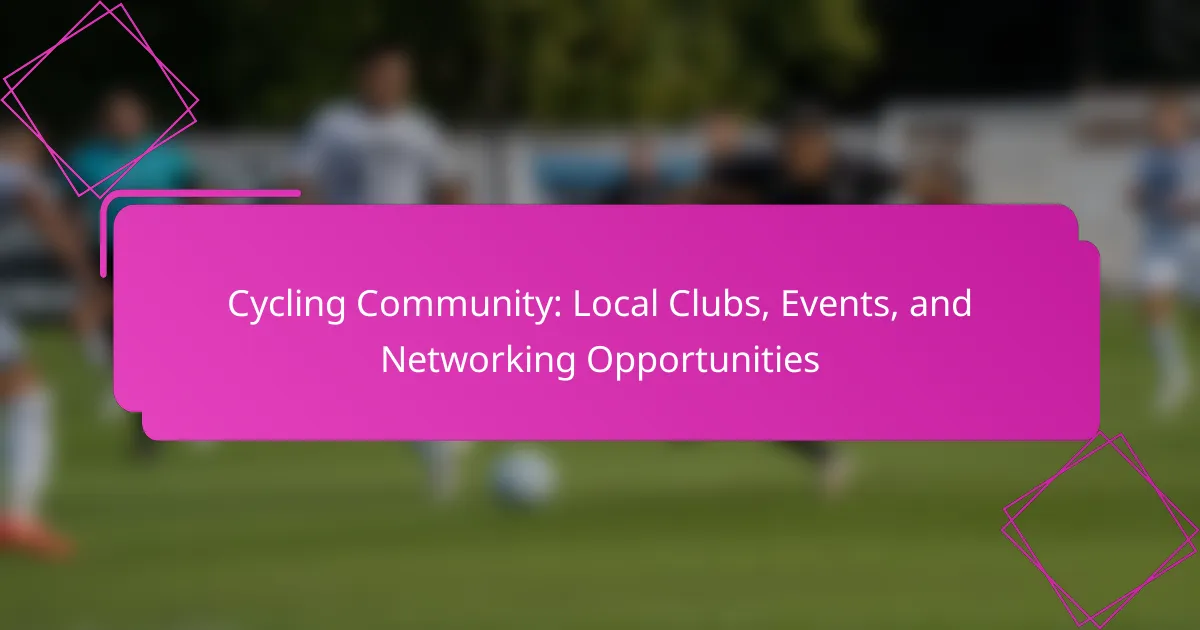Joining a local cycling club enhances your fitness, fosters social connections, and provides access to organized events. Discover popular cycling events that promote community engagement and networking opportunities. Learn how clubs adapt to diverse riders while addressing challenges in funding and infrastructure. Explore the benefits of participating in group rides, workshops, and exclusive events to improve your cycling experience.

What are the key benefits of joining a local cycling club?
Joining a local cycling club offers numerous benefits, including enhanced fitness, social connections, and access to organized events. Members typically experience improved cycling skills through group rides and coaching. Networking opportunities arise, fostering friendships and community involvement. Clubs often provide resources like maintenance workshops and safety training, enriching the cycling experience.
How do cycling clubs foster community engagement?
Cycling clubs foster community engagement by creating inclusive environments for members to connect through shared interests. They organize regular rides, social events, and workshops, enhancing camaraderie among participants. Clubs often collaborate with local businesses and charities, promoting community initiatives and encouraging volunteerism. This involvement not only strengthens local ties but also raises awareness about cycling benefits, such as health and environmental sustainability.
What resources do local clubs provide for cyclists?
Local clubs provide essential resources for cyclists, including organized rides, maintenance workshops, and networking events. These clubs foster community, enhance skills, and offer access to exclusive cycling routes. Members benefit from group support, safety in numbers, and shared knowledge about local cycling conditions. Additionally, many clubs host events that connect cyclists with local businesses, promoting cycling-friendly initiatives and products.
How can local cycling clubs enhance personal fitness?
Local cycling clubs significantly enhance personal fitness by providing structured training, social motivation, and access to events. Group rides encourage consistent exercise, increase endurance, and promote accountability among members. Clubs often organize races and challenges that motivate individuals to improve their performance. Additionally, the social aspect fosters a supportive environment, making fitness more enjoyable and sustainable. Engaging with a community can lead to increased knowledge about cycling techniques and health benefits, ultimately enhancing overall fitness levels.

Which popular cycling events are held annually in various regions?
Numerous popular cycling events occur annually across various regions, attracting enthusiasts worldwide. Notable events include the Tour de France, held in France; the Giro d’Italia, taking place in Italy; and the Vuelta a España, occurring in Spain. Other significant events are the Cape Town Cycle Tour in South Africa, the RideLondon in the UK, and the Amgen Tour of California in the USA. These events foster community engagement and provide networking opportunities for local clubs and cyclists.
What makes charity rides unique in the cycling community?
Charity rides are unique in the cycling community because they combine fitness with philanthropy. Participants not only enjoy cycling but also contribute to meaningful causes. These events foster camaraderie among cyclists while raising funds for various charities. Additionally, they often attract diverse riders, enhancing networking opportunities within local clubs. The sense of purpose and community support distinguishes charity rides from regular cycling events.
How do competitive events differ across local cycling scenes?
Competitive events in local cycling scenes vary significantly based on community engagement, event structure, and participant demographics. Each local club often hosts unique races, from casual criteriums to more formal road races, reflecting the area’s cycling culture.
Local cycling scenes may prioritize different attributes such as race frequency, distance, and terrain. For instance, urban areas may focus on short, fast-paced events, while rural clubs might emphasize endurance rides over longer distances. Additionally, community involvement can differ; some clubs foster a strong social aspect, while others emphasize competitive performance.
The level of competition also varies. In some regions, events attract elite cyclists, while others cater to beginners, creating a diverse range of experiences. Understanding these differences helps cyclists choose events that align with their goals and skill levels.
Which festivals celebrate cycling culture?
Festivals celebrating cycling culture include events like the Tour de France, Sea Otter Classic, and BikeFest. These gatherings foster community, promote cycling, and showcase innovations. Each event offers unique experiences, from competitive races to family-friendly activities, enhancing local cycling networks.

How do networking opportunities within cycling clubs benefit members?
Networking opportunities within cycling clubs significantly benefit members by fostering connections, enhancing skills, and promoting community engagement. Members gain access to experienced cyclists who can offer valuable advice and mentorship. Additionally, clubs often organize events that allow members to participate in group rides, races, and workshops, which build camaraderie and improve cycling techniques. These interactions can lead to lifelong friendships and a supportive environment for personal growth. Furthermore, clubs may provide exclusive access to resources, such as training programs and cycling gear discounts, enhancing the overall cycling experience.
What role do social media platforms play in connecting cyclists?
Social media platforms play a crucial role in connecting cyclists by facilitating communication and event organization. They provide spaces for cyclists to share experiences, advice, and resources. Local clubs leverage these platforms to promote events, recruit members, and foster community engagement. Additionally, social media helps cyclists find networking opportunities, allowing them to connect with fellow enthusiasts and participate in group rides. This connectivity enhances the cycling community, promoting collaboration and shared enthusiasm for the sport.
How can members leverage local events for professional networking?
Members can leverage local events for professional networking by actively participating in cycling clubs and attending organized rides. Engaging in these gatherings fosters connections with like-minded individuals, enhancing both personal and professional relationships.
Local cycling events often feature workshops and seminars, providing opportunities to learn from industry experts. These sessions can help members gain insights into the latest cycling trends and technologies, which can be beneficial for career advancement.
Additionally, members should consider volunteering at events, as it allows for deeper interactions with participants and organizers. This involvement can lead to valuable contacts within the cycling community and related industries.
Finally, utilizing social media to promote attendance at local events can attract more participants, creating a larger network. Sharing experiences and insights online further establishes a member’s presence in the cycling community.
What mentorship opportunities exist within cycling clubs?
Cycling clubs offer various mentorship opportunities for members, fostering skill development and community engagement. These include one-on-one coaching sessions, group rides led by experienced cyclists, and workshops focusing on cycling techniques and maintenance skills. Additionally, clubs often organize events that pair novice riders with mentors for guidance and support. This collaborative environment enhances the cycling experience and encourages growth within the community.

How do local cycling clubs adapt to the needs of diverse riders?
Local cycling clubs adapt to diverse riders by offering tailored programs and inclusive environments. They provide beginner-friendly rides, skill development workshops, and social events that encourage participation from all skill levels. Clubs often focus on creating supportive communities that celebrate diversity in cycling experiences. By actively seeking feedback from members, they can adjust their offerings to better meet the needs of varied riders, ensuring everyone feels welcome and valued.
What programs support youth and beginner cyclists?
Local clubs, youth programs, and beginner events support youth and beginner cyclists by providing resources and community engagement. Organizations like the National Interscholastic Cycling Association offer structured leagues for young riders, while local bike shops often host beginner workshops. Community events like group rides and races encourage participation and skill development. Networking opportunities through social media groups help connect cyclists for mentorship and support.
How do clubs accommodate riders with disabilities?
Clubs accommodate riders with disabilities by providing specialized equipment, accessible routes, and tailored support. Many clubs offer adaptive bikes and trikes to ensure inclusivity. They often organize events that focus on accessibility, fostering a welcoming community. Additionally, collaboration with local organizations enhances resources and training for volunteers, ensuring comprehensive support for all riders.

What unique experiences do regional cycling clubs offer?
Regional cycling clubs offer unique experiences through camaraderie, skill development, and local knowledge. Members participate in organized rides, fostering friendships while improving cycling skills. Clubs often host exclusive events, such as charity rides and competitions, enhancing community engagement. Additionally, local clubs provide insights into regional trails and cycling routes, enriching the overall cycling experience.
How does the local culture influence cycling club activities?
Local culture significantly shapes cycling club activities by influencing participation, event themes, and community engagement. Clubs often reflect local values, traditions, and social dynamics. For example, a region with a strong outdoor recreation culture may host more adventurous rides and events. In contrast, areas with a focus on community health might prioritize family-friendly activities and wellness initiatives. Additionally, local cycling clubs often collaborate with community organizations, enhancing networking opportunities and fostering a sense of belonging among members. This cultural synergy enriches the overall cycling experience, making it more relevant and enjoyable for participants.
What specialized training programs are available in different areas?
Local cycling clubs offer specialized training programs across various areas, focusing on skills, endurance, and competitive racing. These programs often include road cycling, mountain biking, and triathlon training. Many clubs host structured training sessions, workshops, and events to enhance member skills. Networking opportunities arise through group rides, competitions, and community events, fostering connections among cyclists.

Which challenges do local cycling communities face today?
Local cycling communities face challenges such as limited funding, lack of infrastructure, and member retention. These issues hinder growth and participation.
Funding is often scarce, making it difficult to organize events or maintain facilities. Infrastructure, like bike lanes and parking, is frequently inadequate, discouraging new cyclists.
Additionally, retaining members can be tough due to competition from other recreational activities. Addressing these challenges is crucial for fostering vibrant cycling communities.
How do clubs address safety concerns for cyclists?
Clubs address safety concerns for cyclists by implementing various strategies. They often conduct safety workshops to educate members on road rules and safe riding practices. Many clubs collaborate with local authorities to improve cycling infrastructure, such as adding bike lanes and signage.
Additionally, clubs may organize group rides, which enhance visibility and safety in numbers. Some provide resources like reflective gear and helmets to promote safe riding. Regular communication about local hazards and safety updates is also common, ensuring cyclists stay informed and prepared.
What strategies do clubs use to promote sustainable cycling practices?
Clubs promote sustainable cycling practices through education, community events, and partnerships. They often host workshops to teach members about eco-friendly cycling techniques and maintenance. Collaborative events with local businesses encourage the use of bicycles for commuting, reducing carbon footprints. Many clubs also participate in advocacy efforts for improved cycling infrastructure. These strategies not only foster a sense of community but also emphasize the environmental benefits of cycling.
How can clubs combat declining membership rates?
Clubs can combat declining membership rates by enhancing community engagement and offering diverse activities. Organizing regular events fosters social connections among members, attracting new participants. Additionally, leveraging social media to promote events and share success stories can increase visibility and interest. Offering incentives, such as discounts or rewards for referrals, encourages current members to invite friends. Finally, addressing members’ feedback and adapting to their preferences can create a more inclusive environment, ensuring long-term retention.

What best practices can enhance your experience in a cycling club?
Joining a cycling club enhances your experience through community engagement, skill development, and event participation. Actively participating in group rides fosters camaraderie and motivation.
Establishing connections with fellow cyclists can lead to valuable networking opportunities, including local events and races. Regularly attending club meetings and social gatherings strengthens relationships and builds a supportive environment.
Participating in organized events allows for skill improvement and exposure to diverse cycling experiences. Engaging in workshops or training sessions can enhance your cycling techniques and knowledge of bike maintenance.
Lastly, sharing your experiences and insights with club members enriches the collective knowledge and encourages a culture of learning and support within the cycling community.
How to effectively participate in local cycling events?
To effectively participate in local cycling events, join a cycling club, engage with fellow cyclists, and stay informed about upcoming events. Networking enhances your experience and opens opportunities for collaboration.
1. Research local cycling clubs and choose one that aligns with your interests.
2. Attend club meetings and group rides to build relationships.
3. Volunteer for event organization to gain insights and contribute to the community.
4. Follow local cycling social media pages for updates on events and activities.
5. Participate in various events to experience different aspects of cycling.
What are common mistakes to avoid when joining a cycling community?
Common mistakes to avoid when joining a cycling community include not engaging with members, neglecting to participate in events, and failing to communicate your goals. Many newcomers may hesitate to ask questions, which can hinder their integration. Not familiarizing yourself with group etiquette can lead to misunderstandings. Additionally, overlooking safety guidelines during rides can pose risks. Lastly, avoiding social interactions can limit networking opportunities and diminish the overall experience.
How to build lasting relationships within the cycling community?
To build lasting relationships within the cycling community, engage actively with local clubs and events. Participate in group rides and volunteer opportunities.
Networking is essential; connect with fellow cyclists through social media and community forums. Establishing trust and camaraderie enhances your experience and fosters long-term friendships.
Consider joining cycling advocacy groups to meet like-minded individuals who share your passion. Attend workshops and seminars to broaden your knowledge and network further.
Consistency in participation strengthens bonds. Regular involvement demonstrates commitment and opens doors to deeper connections within the cycling community.
